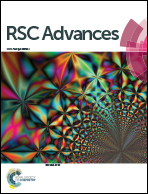High performance hierarchical nanoporous antireflective films by a facile sol–gel process†
Abstract
Single layer antireflection (SLAR) sol–gel films on super white glass substrates were prepared by hierarchically introducing hollow silica nano-spheres (HSNs) and F127 templated nano-pores. HSNs and F127 templated nano-pores were formed by base and acid catalyzed sol–gel processes, respectively. The dispersibility of HSNs was ameliorated by Ph-TES surface modifications. The porosity of the SLAR films was engineered by a step-by-step addition of nano-pores and HSNs so that the refractive index could be tuned to be as low as the desired value of 1.24. It accordingly improved the transmittance of the films with an optimized maximum transmittance of 98.21% in the visible spectral region. Furthermore, the concentration of modified HSNs was adjusted to modulate the peak transmittance wavelength from 550 nm to 680 nm. The nano-scale surface embossments due to the addition of HSNs was also contributory to the antireflective effect of the films, especially at 45° or 5° incident angle. As a result, the average transmittance of the double side coating super white glass was increased by 7.10% at 400–1000 nm with good wear resistance. The porosity directed mechanical durability varied from 6H to 3H (pencil hardness). It displays considerable AR application prospects for suitable optical and optoelectronic devices.


 Please wait while we load your content...
Please wait while we load your content...